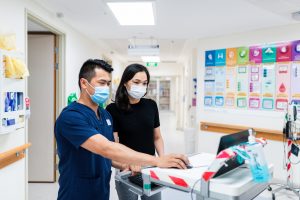Central Adelaide LHN (CALHN) doctors have completed a successful overhaul of the way they produce medical discharge summaries for general practitioners (GPs).
These summaries are critical to ensure the continuity of patient care with their new healthcare provider once they have been discharged from hospital. The reinvented template has now been embedded in CALHN policy following a successful trial period.
Prior to the project, there was no universal template or guidance to support junior Medical Officers in how they brief GPs regarding outgoing patients.
In the absence of a consistent structure, the quality and usefulness of discharge summaries was highly variable. Typical issues included too much or not enough information, heavy use of clinical acronyms and jargon, or inclusion of information not relevant to the GP.
Such issues can have meaningful consequences for patients and GPs alike. Errors in the continuity of medication, such as discontinuing a medication that should continue, are a primary example. Similarly, medical issues can be resolved by hospital staff, only for them to reoccur later due to the GP not being properly informed.
For Hematology Registrar and Project Lead Dr Andrew Vanlint, the clear aim of the handover to GPs project was to realign the focus of medical discharge summaries and redesign them with their intended audiences in mind.
“This is primarily a clinical handover tool,” he stressed.
“The GP is the primary audience and the patient, and their family or caregivers, is the secondary audience. We need to use a structure and language that is respectful and easily approachable to all those parties.
“We have gone back to scratch and thought let’s rethink this and move forward with that purpose in mind.”
Collaborating with community healthcare providers to enable the best possible care is a strategic ambition for the Central Adelaide LHN. Dr Vanlint’s team started the development of the new tool, by asking GPs what they did and did not want in a discharge summary. This initial focus group included a range of junior and senior doctors from rural and metropolitan areas, and provided a clear brief.
The GPs told the developers they wanted:
- a succinct summary
- key events and decisions
- any new or changed diagnoses
- items for GPs to follow up, and a phone call from the treating team if it was urgent
- medication changes and rationale for why
- key investigations
- contact details if there were things they needed to clarify.
The new handover to GPs template developed by Dr Vanlint and his colleagues was based on the established ISBAR model of communication: Introduction – reason for presentation, Situation – past medical history, Assessment – key issues and management during admission, Recommendations – discharge plans. The team further refined the format to also include Investigations – key results and Medications – changes and rational, and an updated medication list.
Dr Vanlint’s team launched a pilot program at The Queen Elizabeth Hospital in November 2020. They trained junior medical staff to use the new tool and allowed them time to become familiar with it. They then compared 60 new discharge summaries written in December 2020 by Cardiology, Upper GI surgery, and Gastroenterology units, to 60 summaries written in October 2020, prior to the launch.
The summaries using the new tool were vastly improved, meeting all targets except one. The key criteria included a complete list of discharge medications and clear instructions for follow-ups, while details of which antibiotics were administered in hospital was the only target not met. The developers concluded that this was likely due to the small sample size of patients in the trial, who generally did not receive antibiotics while in hospital.
The team also received feedback from the trainee medical officers and GPs.
The survey responses from the trainee medical officers indicated that the new format did not take more time and provided significantly better structure, clarity, and purpose.
As a positive side-effect of the process, the trainees reported that the templates promoted important learning discussions with their supervising doctors and 83 per cent of the trainees said they fully supported using the template moving forward.
Dr Jackie Yeoh, CALHN’s GP Liaison Officer and Medical Lead for the CALHN COVID Care Centre, received positive feedback from the GPs.
“Did they find the discharge summaries easier to read, [could they] find the information they wanted and [was the information] more complete? The answer was ‘yes,’” she said.
The final adjustments to the development included incorporating prompts from a medication discharge handover framework being developed separately by Pharmacist Cheyne Sullivan and Medical Admin Registrar Amy Stern.
“That was really great to be able to utilise their data and experience to augment our project,” Dr Vanlint reflected.
The new framework was then endorsed by The National Safety and Quality Health Service, under the Communicating for Safety Standard, before becoming official CALHN policy.
Since then, the handover to GPs template has been adopted by interns and junior doctors in the Southern Adelaide Local Health Network (SALHN) and is in the final stages of being formally adopted by the organisation.
The new framework provides a consistent structure but is flexible for individual medical units to customise to their specific needs. Cardiologists, for example, can choose to include certain information relevant to common presentations to their unit, such as chest pain.
Dr Vanlint has also highlighted the potential for an ‘express’ version of the framework to be developed for circumstances where a comprehensive discharge summary is not necessary, such as day surgery patients.
The successful development and implementation of the new framework is sure to improve the workflow of South Australian GPs and the care they can provide to their patients.
“I think this is another step in the right director for improving how we communicate to our key stakeholders,’ says Dr Vanlint.
“It’s making sure that we are documenting the good things that are happening for our patients, and handing over that good work, to continue with our key contacts in the community.’
Audits of the new discharge summaries will continue to be undertaken across all units in CALHN. Meanwhile, GPs in the community have embraced the change.
“Consistently, since the trial was implemented, I’m getting really nice feedback that they come faster, that they’re much clearer to read, that it’s easier to find the information they need, and that the GPs are really pleased about it,” Dr. Yeoh summarised.



